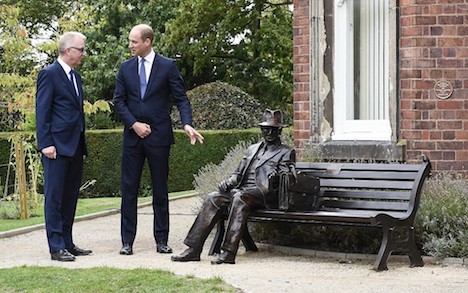Prince William unveils statue of British spy Frank Foley, who saved 10,000 Jews
Duke of Cambridge presents monument of MI6 hero in Midlands town of Stourbridge, to honour his work saving Jews from the Holocaust.
Prince William has demonstrated yet again how seriously he takes Holocaust education by unveiling a statue to honour a British spy who saved 10,000 Jews by issuing them with passports while working undercover in Berlin.
His Royal Highness, who appears to be following in his father’s footsteps, unveiled the statue to MI6 hero Frank Foley in the Midlands town of Stourbridge, where the veteran intelligence officer of two world wars chose to retire.
Prince William speaking with those that Frank Foley saved and HET’s Karen Pollock (far right).
It is the latest noteworthy involvement from the prince, who was visibly moved in June during his visit to Yad Vashem, Israel’s national Holocaust memorial centre.
Months earlier, William and wife Kate visited the Nazi concentration camp of Stutthof in occupied Poland, where they met two Holocaust survivors – Zigi Shipper and Manfred Goldberg – who had witnessed the camp’s horrors.
Unveiling the statue on Tuesday, William met members of Foley’s family, as well as people who were saved by Foley and descendants of others that Foley rescued in the 1920s and 1930s, in so doing putting his own safety at considerable risk.
Local MP Ian Austin, who spearheaded the campaign for a statue together with the Holocaust Educational Trust (HET), paid tribute to Foley, who worked undercover as a Passport Control Officer in the British Consulate in pre-war Berlin.
“I hope it will help people learn how Frank Foley refused to stand by when people were being persecuted because of their race or religion,” said Austin. “His life and courage show us that we all have a responsibility to stand up against intolerance and racism.”
Foley’s work, which – if discovered – would have led to his torture and execution, remained an official secret until long after his death in 1956, when those he had saved chose to speak out. Further research by the author Michael Smith led to Foley’s story being told in Smith’s book ‘The Spy Who Saved 10,000 Jews.’
MI6 boss Alex Younger said that normally “our successes are private, our failures public,” but added: “It is a wonderful thing for MI6 that one of its most distinguished members’ successes are no longer private.”
HET chief executive Karen Pollock said the intelligence officer “went to remarkable lengths to save Jews, right under the nose of the Nazis, even visiting concentration camps to remove them”. She added: “Foley is the ultimate role model. His heroic stand should be a source of pride and inspiration to us all.”
Werner Lachs, who was issued a visa by the spy in 1939, said: “The courageous and brave actions of Frank Foley made it possible for me to escape the hell of Nazi Germany. But for him, I too would have been a victim of the Holocaust. He was my saviour. I shall always honour and cherish his memory.”
Chief Rabbi Ephraim Mirvis added his voice to the chorus of appreciation, saying: “The sheer scale of what Frank Foley achieved, as the impending catastrophe of the Holocaust drew closer, is among the very finest testimonies to human bravery.
“As a timeless reminder of what we are capable of, ever more necessary today, there are few people more deserving of being cast in statue form than he is.”
